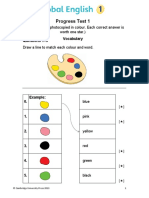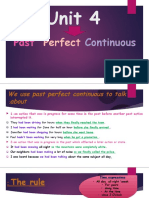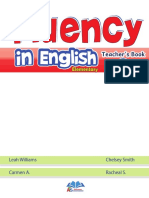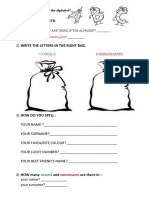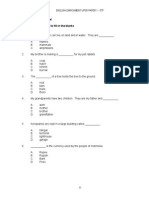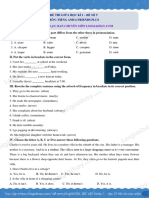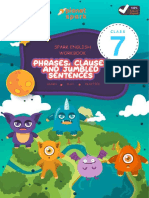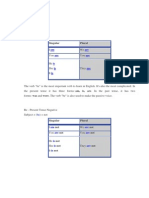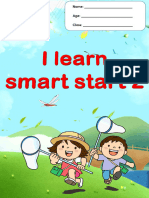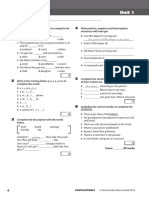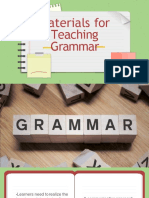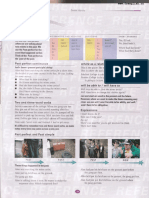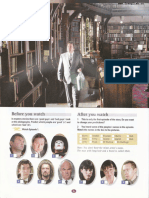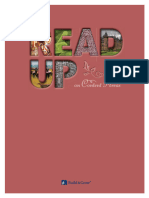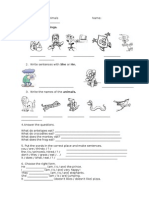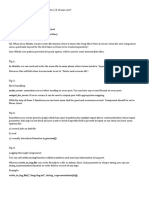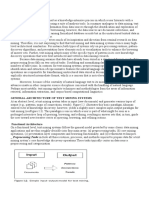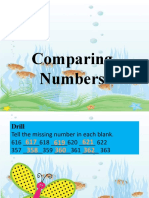Grammar Usage 1 (Fliphtml)
Uploaded by
أحمد الشهريGrammar Usage 1 (Fliphtml)
Uploaded by
أحمد الشهري1
Grammar
a r
Usage
Alston’s Grammar Usage uses the concept-to-context approach of learning English for young
G ra m m
Usage
learners. Language and grammar rules are presented to the learner gradually through examples
and practices in the book, starting from the introduction of a concept through examples and
later progressing to practices in various formats. All these are designed to help the learner
acquire language and grammar skills progressively and systematically.
1
Attractive and colourful pictures and illustrations accompany grammar points, examples and
practices to facilitate a better understanding and clarity of these activities. The concepts are
grouped into learning sections of:
• language units, where on concept is presented in one unit;
• a review of the units in the form of practice; and
• a set of worksheets, one for each unit.
Grammar Usage comprises 3 books in the series and is aimed at learners in the primary schools.
ISBN 978-981-4370-48-6
Empowering Minds
Improving Lives www.alstonpublishinghouse.com 9 789814 370486
Grammar Usage 1.indd 1 7/30/12 4:36 PM
G ra m m a r
Usage
[1] Elfin Grammar Practice 1 A 2PP.indd 1
1 14/8/12 9:28 AM
Published by Alston Publishing House Pte Ltd
745 Lorong 5 Toa Payoh, #03-07, Singapore 319455
enquiry@alstonpublishinghouse.com
www.alstonpublishinghouse.com
© 2012 Alston Publishing House Pte Ltd
All rights reserved. No part of this publication may be
reproduced, stored in a retrieval system, or transmitted
in any form or by any means, electronic, mechanical,
photocopying, recording, or otherwise, without the prior
permission of the copyright owner.
First published 2012
Second impression 2014
Third impression 2018
ISBN 978-981-4370-48-6
Publisher: Sim Wee Chee
Printed by Replika
[1] Elfin Grammar Practice 1 A 2PP.indd 2 8/11/17 11:54 AM
Contents
Unit 1 Nouns 4
Unit 2 Articles: A/An 6
Unit 3 Regular Nouns 8
Unit 4 Irregular Nouns 10
Review Units 1–4 12
Practice Units 1–4 14
Unit 5 Subject Personal Pronouns 18
Unit 6 Object Personal Pronouns 20
Unit 7 Possessive Adjectives 22
Unit 8 Possessive Nouns: The Apostrophe 24
Review Units 5–8 26
Practice Units 5–8 28
Unit 9 Demonstrative Pronouns 32
Unit 10 Subject-Verb Agreement 34
Unit 11 Negative Sentences 36
Unit 12 Using the Verb ‘To Be’ 38
Review Units 9–12 40
Practice Units 9–12 42
Unit 13 Regular Verbs 46
Unit 14 Irregular Verbs 48
Unit 15 Contractions in Negative Sentences 50
Unit 16 The Verb ‘To Do’: Yes/No Questions 52
Review Units 13–16 54
Practice Units 13–16 56
Unit 17 Imperatives 60
Unit 18 Modals: Can/Can’t 62
Unit 19 Modals: Can …? 64
Unit 20 Modals: Should/Shouldn’t 66
Review Units 17–20 68
Practice Units 17–20 70
Answers 74
[1] Elfin Grammar Practice 1 A 2PP.indd 3 14/8/12 9:28 AM
UNIT
1 Nouns
Grammar Point
A noun is a word that names people, animals, places or things.
People Animals
teacher cat
boy
girl fish
mouse
Places Things
cake
house present
garage table
garden
Examples
• Students go to school.
• The cat is under the table.
A. Circle the correct group. The first one has been done for you.
1. person 2. person
animal animal
place place
flower bee
thing thing
3. person 4. person
animal animal
place place
hospital doctor
thing thing
4
[1] Elfin Grammar Practice 1 A 2PP.indd 4 14/8/12 9:28 AM
B. Write in the space provided the group that each noun belongs to.
One has been done for you.
People Animals
cook
bird frog
cook
Places Things
tomato
zoo
beach
baby
robot
C. Choose the correct nouns and write them in the blanks provided.
puppy school balloon grandmother
1. A has soft fur.
2. My likes books.
3. The is red.
4. I walk to every day.
D. Fill in each blank with one of the nouns given. The first one has
been done for you.
Charles is a king . castle
king
He lives in a .
He has a white . horse
carrot
The king feeds the horse a .
[1] Elfin Grammar Practice 1 A 2PP.indd 5 14/8/12 9:28 AM
UNIT
2 Articles: A, An
Grammar Point
An article is a word that we put before a noun. We use ‘a’ with a
consonant sound and ‘an’ with a vowel sound.
A / An + noun
A + consonant An + vowel [a, e, i, o, u]
a banana a house an apple an arrow
a lion a queen an egg an iguana
a tree a violin an octopus an umbrella
Examples
• I have a violin.
• That is an elephant.
A. Circle the noun with the correct article. The first one has been
done for you.
1. a orange 2. a chair
an orange an chair
3. a hat 4. a ant
an hat an ant
[1] Elfin Grammar Practice 1 A 2PP.indd 6 14/8/12 9:28 AM
B. Write the correct noun in each space. The first one has been done
for you.
eraser turtle
pencil alien
igloo rabbit
a pencil
an
C. Write the noun with its correct article in the blank. The first one has
been done for you.
artist spider tail ostrich
1. It is a spider .
2. Amy is .
3. is a bird.
4. A monkey has .
D. Fill in each blank with one of the nouns given. The first one has
been done for you.
elephant
Ted is a magician . magician alligator
He has . It is big.
There are and hat
in the hat.
7
[1] Elfin Grammar Practice 1 A 2PP.indd 7 14/8/12 9:28 AM
UNIT
Regular Nouns
3
Grammar Point
Plural nouns are used to name more than one person, place, animal
or thing.
Noun + s Noun [-ch, -sh, -x, or -s] + es
one two or more one two or more
shoe shoes watch watches
book books dish dishes
ball balls box boxes
shirt shirts bus buses
Examples
• I like my new shoes.
• Paul has three pocket watches.
A. Circle the correct plural noun. The first one has been done for you.
1. peachs 2. eggs
peaches egges
3. crayons 4. foxs
crayones foxes
[1] Elfin Grammar Practice 1 A 2PP.indd 8 14/8/12 9:29 AM
B. Match each noun to the correct picture and then write its plural noun
in the space provided. The first one has been done for you.
1. snake three snakes
2. car
3. sandwich
4. toothbrush
C. Write the correct plural noun of the word in blue. The first one has
been done for you.
1. Emma has two dog. dogs
2. There are two benchs.
3. The house has five windowes.
4. I have four class today.
D. Fill in each blank with the correct plural form of the nouns given.
The first one has been done for you.
apple sandwich squirrel dish
We are in the park. In the basket,
there are three sandwiches ,
three and four
. Look! There are
two on the tree.
[1] Elfin Grammar Practice 1 A 2PP.indd 9 14/8/12 9:29 AM
UNIT
Irregular Nouns
4
Grammar Point
Some plural nouns are formed in others ways besides adding ‘s’.
Nouns ending in consonant + y Nouns with different plural forms
baby babies tooth teeth
candy candies mouse mice
Nouns ending in -f, -fe Nouns with no change
leaf leaves sheep sheep
knife knives fish fish
Examples
• Children like candies.
• Wolves eat sheep.
A. Circle the correct plural noun. The first one has been done for you.
1. deer 2. wolfes
deers wolves
Paris
3. citys 4. foot
cities feet
Sydney
New York
10
[1] Elfin Grammar Practice 1 A 2PP.indd 10 14/8/12 9:29 AM
B. Match each noun to the correct picture and then write the correct
plural noun. The first one has been done for you.
1. child
2. dwarf
3. goose
4. man three children
C. Write the correct plural noun of the word in blue. The first one has
been done for you.
1. There are three lilyes. lilies
2. The baby has two toothes.
3. There are four sheeps.
4. I have three dictionarys.
D. Complete the passage by filling each space with the correct plural
noun of the words given. The first one has been done for you.
thief mouse fish fly
There are two thieves .
One of them has a big bag.
In his bag, there are two
, three
and three .
11
[1] Elfin Grammar Practice 1 A 2PP.indd 11 14/8/12 9:29 AM
Review Units 1–4
A. Match each noun with the correct picture and then match it to the
correct group. The first one has been done for you.
1. dentist person
2. store animal
3. jacket place
4. rabbit thing
B. Fill in each blank with the correct noun from the box.
apron hairdresser desk onion eagle teddy bear
1. 2.
3. 4.
5. 6.
12
[1] Elfin Grammar Practice 1 A 2PP.indd 12 14/8/12 9:29 AM
C. Fill in each blank with the correct plural noun.
1. + = (box)
2. + = (snail)
3. + = (ring)
4. + = (dress)
5. + = (brush)
D. Rewrite each sentence using the correct plural nouns.
1. The childs chase butterflyes.
Answer:
2. The snowman wear scarfs.
Answer:
3. There are strawberrys and fishes.
Answer:
4. I brush my tooth and wash my foot.
Answer:
13
[1] Elfin Grammar Practice 1 A 2PP.indd 13 14/8/12 9:29 AM
Practice
Unit 1
A. Fill in each blank with a word from the box on the right.
1. people
baby
frog
castle
2. animals
bee
cake
balloon
3. places fish
beach
cook
girl
4. things
robot
garage
B. Circle the odd one out.
1. table yard tomato present flower
2. house king zoo hospital school
3. cat mouse carrot horse bird
4. teacher boy puppy grandmother doctor
14
[1] Elfin Grammar Practice 1 A 2PP.indd 14 14/8/12 9:29 AM
Practice
Unit 2
A. Circle the correct article and fill in each blank with the correct
word from the box.
violin tree elephant artist hat umbrella
1. 2. 3.
(a / an) (a / an) (a / an)
4. 5. 6.
(a / an) (a / an) (a / an)
B. Fill in each list with the correct word from the box.
banana
a lion an
arrow
iguana
queen
eraser
spider
chair
octopus
igloo
15
[1] Elfin Grammar Practice 1 A 2PP.indd 15 14/8/12 9:29 AM
Practice
Unit 3
A. Fill in each blank with the correct plural noun.
1. 2. 3.
bench book snake
4. 5. 6.
bus dish crayon
B. Fill in each list with the correct plural noun from the box.
ball
-s peach -es
car
box
egg
shirt
fox
toothbrush
class
window
16
[1] Elfin Grammar Practice 1 A 2PP.indd 16 14/8/12 9:29 AM
Practice
Unit 4
A. Circle the correct plural noun.
1. mouse mouse mice mouses
2. sheep sheep sheeps shoop
3. tooth tooth teeth toothes
4. candy candys candyes candies
5. leaf leafs leafes leaves
6. man man men mans
B. Fill in each blank with the correct plural noun.
Singular Plural Singular Plural
a wolf three a foot two
a woman four a deer two
a baby two a knife three
a thief four a city five
a fly seven a child six
17
[1] Elfin Grammar Practice 1 A 2PP.indd 17 14/8/12 9:29 AM
UNIT
5 Subject Personal Pronouns
Grammar Point
A subject personal pronoun replaces the subject in a sentence.
Singular Plural
You and I are students.
We are friends.
I am Ann. You are Tom.
You are Tom and Sally.
You are classmates.
He is my father. She is my mother.
He and she are my parents.
They are my parents.
It is my dog. It is my doll.
Contractions
I am = I’m He is = He’s She is = She’s It is = It’s
You are = You’re We are = We’re They are = They’re
A. Circle the correct subject pronoun. The first one has been done for
you.
1. it 2. I
you you
we we
they they
3. she 4. it
he she
we we
they they
18
[1] Elfin Grammar Practice 1 B 2PP.indd 18 17/11/17 10:18 AM
B. Match each subject pronoun with the correct word. The first one
has been done for you.
I She They He It You We
am is are
C. Write a pronoun for the word or words in blue. The first one has
been done for you.
1. Mark is handsome. He
2. You and Sam are soccer players.
3. Kate and I are at the playground.
4. Kevin and Laura are a couple.
D. Fill in the blanks with pronouns and verbs. The first one has been
done for you.
Tom is my friend. He is smart.
Sally is my friend. pretty.
my best friends.
in the same class.
19
[1] Elfin Grammar Practice 1 B 2PP.indd 19 17/11/17 10:18 AM
UNIT
6 Object Pronouns
Grammar Point
An object personal pronoun replaces the object in a sentence.
Singular Plural
I love you.
You love me.
Do you know them?
He loves her. They’re waving to us.
She loves him.
Tom is throwing the ball. You are my students.
Andy is hitting it. I teach you English.
A. Circle the correct pronoun. The first one has been done for you.
1. Look at ( she / her )! 2. Look at ( we / us )!
3. Look at ( it / them )! 4. Look at ( him / her )!
20
[1] Elfin Grammar Practice 1 B 2PP.indd 20 17/11/17 10:18 AM
B. Complete the table by filling in the correct pronouns. The first one
has been done for you.
Singular Plural
Subject Object Subject Object
I me
we
you
he you
her
they
it
C. Write a pronoun for the words in blue. The first one has been done
for you.
1. Look at the flowers! them
2. Sam washes the dog.
3. Can you see Peter?
4. Sit next to Jenny.
D. Fill in each blank with a pronoun. The first one has been done for
you.
Today is Amy’s birthday.
Her mother bakes her a cake.
She likes very much.
Her father gives two storybooks.
She likes very much, too.
21
[1] Elfin Grammar Practice 1 B 2PP.indd 21 17/11/17 10:18 AM
UNIT
Possessive Adjectives
7
Grammar Point
A possessive adjective shows us to whom an object belongs.
Possessive adjective + noun
Singular I my brother (he) his sunglasses
you your friend (she) her cat (it) its ball
you your parents (they) their house
Plural
we our school
A. Circle the correct adjective. The first one has been done for you.
1. ( my / your ) shirt 2. ( his / their ) ball
3. ( his / her ) notebook 4. ( your / our ) dog
22
[1] Elfin Grammar Practice 1 B 2PP.indd 22 17/11/17 10:18 AM
B. Fill in each blank with the adjective from the box. The first one has
been done for you.
my your his her its our their
1. mother her shoes 2. Logan and I shoes
3. boy ball 4. girls school
5. you dog 6. cat tail
C. Write the correct adjective in each blank.
you I Amy Kevin David Kate
Colour of
black brown blond brown gray gray
hair
1. I am Ann. hair is .
2. Amy is pretty. hair is .
3. Kevin and I are brother and sister. hair is .
4. You are Tom. hair is .
5. David and Kate are my grandparents. hair is
.
D. Fill in each blank with the correct adjective. The first one has been
done for you.
This is my friend. Her name is Beth.
Beth has a brother. name is Jay.
Beth and Jay have a horse.
horse looks beautiful.
Beth Jay Miracle
name is Miracle.
23
[1] Elfin Grammar Practice 1 B 2PP.indd 23 17/11/17 10:18 AM
UNIT
Possessive Nouns: The Apostrophe
8
Grammar Point
A possessive noun shows to which living thing or object something
belongs. An apostrophe is used to show this.
Plural
Singular: Noun + ’s
Regular: Noun + ’ Irregular: Noun + ’s
Jenny’s dog’s house boys’ bags children’s books
doll
firefighter’s
giraffe’s neck birds’ song women’s team
uniform
A. Circle the correct possessive noun. The first one has been done
for you.
1. men’ ties 2. Tom’ shirt
men’s ties Tom’s shirt
3. cats’ milk 4. my sister toys
cats’s milk my sister’s toys
24
[1] Elfin Grammar Practice 1 B 2PP.indd 24 17/11/17 10:18 AM
B. Fill in each blank with the correct possessive noun. The first one
has been done for you.
1. sister sister’s dress 2. dog nose
3. Brian cat 4. mice cheese
5. students desks 6. babies toys
C. Fill in each blank with the correct possessive noun from the box.
The first one has been done for you.
the girls Sally Danny Kevin and Laura my father
1. Whose house is this? It’s Kevin and Laura’s house.
2. Whose scarves are these? They’re scarves.
3. Whose glasses are these? They’re glasses.
4. Whose bike is this? It’s bike.
5. Whose hats are these? They’re hats.
D. Fill in each blank with the correct possessive noun. The first one
has been done for you.
Today is children’s (children) day.
Alex and Beth are at the zoo.
The (lion) teeth are sharp.
The (hippopotamus) mouth is big.
The (monkeys) tails are long.
25
[1] Elfin Grammar Practice 1 B 2PP.indd 25 17/11/17 10:18 AM
Review Units 5–8
A. Fill in each blank with We, You or They.
1. + 2. +
3. + 4. +
5. + 6. +
B. Circle the correct pronoun.
1. Mary is my friend. ( She / He ) is ten years old.
2. This is my cat. ( I / It ) has three kittens.
3. He is a student. I am a student too. ( We / They ) are
students.
4. We are studying. Don’t talk to ( us / them ).
5. This is my mother. She loves ( I / me ).
6. Where are my socks? I can’t find ( it / them ).
26
[1] Elfin Grammar Practice 1 B 2PP.indd 26 17/11/17 10:18 AM
C. Write the correct possessive noun and pronoun, as shown in the
example.
Laura Laura’s skirt her skirt
1. monkey banana banana
2. Andy sisters sisters
3. cat and dog balls balls
4. David and Kate car car
D. Fill in each blank with the correct pronoun.
1. 2.
I am a student. The rabbit is white.
This is book. tail is short.
3. 4.
She is a police officer. Sam, show me
hands. Are
This is they clean?
uniform.
5. 6.
They are my cats. I’m Ted, and this is my wife
Betty.
names are
Lulu and Juju. This is baby.
27
[1] Elfin Grammar Practice 1 B 2PP.indd 27 17/11/17 10:18 AM
Practice
Unit 5
A. Fill in each blank with the correct pronoun from the box.
I You He She It We They
1. 2.
is a teacher. am Ann.
3. 4.
is a student. is my father.
5. 6.
are friends. is my dog.
7. 8.
are my parents. is my doll.
B. Circle the correct word and rewrite each sentence using the
correct pronoun for the noun in blue.
1. Mark ( am / is ) handsome.
2. Kevin and Lora ( is / are ) a couple.
3. Sara ( is / am ) my mother.
4. Kate and I ( am / are ) at the playground.
5. You and Sam ( is / are ) soccer players.
6. Sally ( is / are ) pretty and smart.
7. You and I ( am / are ) students.
8. Sally and Lora ( is / are ) sisters.
28
[1] Elfin Grammar Practice 1 B 2PP.indd 28 17/11/17 10:18 AM
Practice
Unit 6
A. Circle the correct pronoun.
1. 2.
Look at ( they / them )! Sit next to ( her / him ).
3. 4.
She is waving to ( I / you ). He is hitting ( it / them ).
5. 6.
Look at ( it / them )! You love ( me / I ).
7. 8.
Can you see ( he / him )? He teaches ( it / us ).
B. Fill in each blank with the correct pronoun.
1. He loves . (she)
2. I love . (my father)
3. My father gives story books. (I)
4. Look at ! (the dog)
5. The teacher teaches English. (we)
6. Do you know ? (the students)
7. Tom is throwing . (the ball)
8. Can you see ? (Jenny)
29
[1] Elfin Grammar Practice 1 B 2PP.indd 29 17/11/17 10:18 AM
Practice
Unit 7
A. Fill in each blank with the correct pronoun from the box.
my your his her its our their
1. 2.
school. house.
3. 4.
sunglasses. grandparents.
5. 6.
shirt. ball.
7. 8.
friend. cat.
B. Fill in each blank with the correct pronoun.
1. That is a cat. tail is long.
2. Beth has a brother. name is Jay.
3. Look at the rabbits. eyes are red.
4. We are David and Kate. This is house.
5. You have a dog. dog is white.
6. This is Amy. father is a police officer.
7. These are my classmates. names are Tom and Sally.
8. I walk to school every day. The school is near house.
30
[1] Elfin Grammar Practice 1 B 2PP.indd 30 17/11/17 10:18 AM
Practice
Unit 8
A. Look at the pictures and fill in each blank with the correct
possessive noun.
father mother
parents
1. scarves 2. car
3. hats 4. bag
5. ties 6. bike
7. house 8. glasses
B. Fill in each blank with the correct possessive noun.
1. The (men) team plays soccer.
2. This is the (doctor) desk.
3. Don’t touch the (magician) wand!
4. I clean the (boys) room.
5. We visit the (king and queen) castle.
6. I read (Wendy) book.
7. The (girls) dresses are so pretty!
8. Those are my (sister) glasses.
31
[1] Elfin Grammar Practice 1 B 2PP.indd 31 17/11/17 10:18 AM
UNIT
9 Demonstrative Pronouns
Grammar Point
A demonstrative pronoun is used to identify a noun.
Near you Far from you
This That
Singular
This is a flower. That is a plane.
These Those
Plural
These are flowers. Those are planes.
A. Circle the correct word. The first one has been done for you.
1. ( This / That ) is a fish. 2. ( This / That ) is a bird.
3. ( These / Those ) are birds. 4. ( These / Those ) are fish.
32
[1] Elfin Grammar Practice 1 C 2PP.indd 32 17/11/17 10:20 AM
B. Fill in each blank with This is or That is. The first one has been
done for you.
1. This is an ant.
2. a book.
3. a tree.
4. a ball.
5. an elephant.
C. The word in blue is wrong. Write the correct word in the space
provided. The first one has been done for you.
1. That are cows. Those
2. These is a watch.
3. This are strawberries.
4. Those is a kite.
D. Fill in the blanks with pronoun and verbs. The first one has been
done for you.
This is my father.
our telescopes.
Look at the sky!
a spaceship.
aliens in the spaceship.
33
[1] Elfin Grammar Practice 1 C 2PP.indd 33 17/11/17 10:20 AM
UNIT
10 Subject-Verb Agreement
Grammar Point
A singular subject takes a singular verb and a plural subject takes a
plural verb. This is called subject-verb agreement.
There is + singular There are + plural
There is an apple. There are five apples in the basket.
There is a fly. There are two flies in my soup.
A. Circle the correct word. The first one has been done for you.
1. There ( is / are ) three books. 2. There ( is / are ) a car.
3. There ( is / are ) an umbrella. 4. There ( is / are ) two bats.
34
[1] Elfin Grammar Practice 1 C 2PP.indd 34 17/11/17 10:20 AM
B. Complete the table by using is or are. The first one has been done
for you.
1. are three books
2. a ruler
There 3. three notebooks in my bag.
4. five pencils
5. an eraser
C. Draw each of the things in blue in the refrigerator. The first one has
been done for you.
1. There is a watermelon.
2. There are three peaches.
3. There are two fish.
4. There is an ice cream.
5. There are six eggs.
D. Fill in the blanks with There and is or are. The first one has been
done for you.
This is Van Gogh’s painting called ‘Bedroom’.
There is a bed.
two pillows
on the bed.
a small table.
two chairs.
35
[1] Elfin Grammar Practice 1 C 2PP.indd 35 17/11/17 10:20 AM
UNIT
Negative Sentences
11
Grammar Point
Negative sentences are formed using the word not.
Subject + ‘be’ (am / are / is) + not
I am not a doctor. You are not angry.
I am a cook. You are hungry.
She is not a pianist. We are not teachers.
She is a singer. We are police officers.
It is not a cat. They are not hats.
It is a tiger. They are socks.
Contractions
I am not = I’m not
She / He / It is not = She / He / It isn’t
You / We / They are not = You / We / They aren’t
A. Circle the correct word or words in the brackets. The first one has
been done for you.
1. I ( am / am not ) a nurse. 2. He ( is / is not ) a scientist.
3. It ( is / is not ) a skirt. 4. They ( are / are not ) twins.
36
[1] Elfin Grammar Practice 1 C 2PP.indd 36 17/11/17 10:20 AM
B. Use a contraction for the words in blue. The first one has been
done for you.
1. It is not a violin. It isn’t a violin.
2. They are not firefighters. They firefighters.
3. You are not happy. You happy.
4. She is not hungry. She hungry.
5. He is not my teacher. He my teacher.
C. Complete each sentence about the picture following the example
shown.
1. 2.
It is an alligator. They baseball players.
It isn’t an octopus. They basketball players.
3. 4.
She a singer. They bees.
She a ballerina. They butterflies.
D. Complete the passage by using the correct subject-verb
agreement. The first one has been done for you.
Nicky and Alex look alike, but they aren’t twins.
They brothers.
Nicky tall but Alex tall.
Nicky thin but Alex thin.
Nicky Alex
37
[1] Elfin Grammar Practice 1 C 2PP.indd 37 17/11/17 10:20 AM
UNIT
Using the Verb ‘To Be’
12
Grammar Point
The verb to be can be used to in ‘Yes’ and ‘No’ answers.
‘Be’ (am / is / are) + subject
Am I a student? Are you happy?
Yes, I am. No, I’m not.
I am sad.
Is he a teacher?
No, he isn’t. Are we lost?
He is a pilot. Yes, we are.
Are they ducks?
Is it a school bus? No, they aren’t.
Yes, it is. They are chickens.
Question Answer
Am I / Are we …? Yes, you are. No, you aren’t.
Are you …? Yes, I am. / Yes, we are. No, I’m not. / No, we aren’t.
Is she / he / it …? Yes, she / he / it is. No, she / he / it isn’t.
Are they …? Yes, they are. No, they aren’t.
A. Circle the correct words. The first one has been done for you.
1. ( She is / Is she ) a doctor? 2. ( He is / Is he ) happy?
3. ( Is it / Are they ) pencils? 4. ( Is it / Are they ) an iguana?
38
[1] Elfin Grammar Practice 1 C 2PP.indd 38 17/11/17 10:20 AM
B. Rearrange each group of words to form a question. The first one
has been done for you.
1. they / Are / hungry Answer: Are they hungry?
2. I / Am / happy Answer:
3. dentist / a / she / Is Answer:
4. Are / a / student / you Answer:
5. it / fish / a / Is Answer:
C. Answer the questions. The first one has been done for you.
1. 2.
Is he thirsty?
Is it a plane?
Yes , he is .
, .
3. 4.
Are you angry? Are they frogs?
, . , .
D. Complete the passage by using the correct subject-verb
agreement. The first one has been done for you.
“ Are you at home?” “ Yes , I am .”
“ your parents at home?”
“ , .”
“ your sister at home?”
“ , .”
“ your puppy at home?”
“ , .”
39
[1] Elfin Grammar Practice 1 C 2PP.indd 39 17/11/17 10:20 AM
Review Units 9–12
A. Fill in each blank with the correct pronoun from the box and circle the
correct verb in the brackets. The first one has been done for you.
This That These Those
1. 2.
( is / are ) a clock. ( is / are ) stars.
3. 4.
( is / are ) ducks. ( is / are ) a kite.
5. 6.
( is / are ) bees. ( is / are ) a cap.
B. Write complete sentences starting with There is or There are. The
first one has been done for you.
1. swing
There are two swings.
2. bench
.
3. child
.
4. tree
.
5. slide
.
6. balloon
.
40
[1] Elfin Grammar Practice 1 C 2PP.indd 40 17/11/17 10:20 AM
C. Use the family tree to complete each sentence using the verb to
be. The first one has been done for you.
1. I am not Amy.
I Judy.
Grandmother Grandfather
2. Ashley my Susan Alan
mother.
3. Derek my
uncle. Mother Father Aunt Uncle
4. Susan and Alan Ashley Derek Jennifer Chris
my
grandparents.
5. Jennifer and Chris
Me Brother Sister
husband Judy Brian Amy
and wife.
6. Brian Susan
and Alan’s son.
D. Use the pictures to complete each question and answer.
1. 2.
she happy? you students?
, . , .
3. 4.
it a snail? they toys?
, . , .
41
[1] Elfin Grammar Practice 1 C 2PP.indd 41 17/11/17 10:20 AM
Practice
Unit 9
A. Fill in each blank with the correct words from the box.
This is That is These are Those are
1. 2.
a book. a plane.
3. 4.
a ball. cows.
5. 6.
flowers. a kite.
7. 8.
fish. birds.
B. Circle the correct word.
1. ( This / That ) is a snail in my hand.
2. ( This / That ) is his car over there.
3. Look here! ( These / Those ) are ants.
4. Pass me ( that / those ) pencils.
5. Look at ( these / those ) birds flying in the sky!
6. Who is the man over there? ( This / That ) is my uncle.
7. ( This / These ) are my parents, and ( that / those ) is my teacher.
8. I like ( this / these ) watch, but I don’t like ( that / those ) shoes.
42
[1] Elfin Grammar Practice 1 C 2PP.indd 42 17/11/17 10:20 AM
Practice
Unit 10
A. Complete the table by writing is or are.
1. a sofa
2. four bookshelves
3. a desk
4. two lamps
There in the living room.
5. a TV
6. three cats
7. two clocks
8. a table
B. Count and write the correct number of items in a sentence. Each
sentence should begin with There.
1.
2.
3.
4.
5.
6.
7.
43
[1] Elfin Grammar Practice 1 C 2PP.indd 43 17/11/17 10:20 AM
Practice
Unit 11
A. Fill in each blank with the correct word or words from the box.
am ’m not are aren’t is isn’t
1. 2.
She a ballerina. They gloves.
3. 4.
I hungry. He a cook.
5. 6.
It a cat. You twins.
7. 8.
They pants. I a doctor.
B. Rearrange each group of words into a negative sentence.
1. is / It / a / not / hat
2. You / tall / are / not
3. We / not / are / nurses
4. here / are / not / They
5. is / an / octopus / not / It
6. am / I / not / scientist / a
7. I / a / firefighter / not / am
8. not / my / is / She / teacher
44
[1] Elfin Grammar Practice 1 C 2PP.indd 44 17/11/17 10:20 AM
Practice
Unit 12
A. Complete the table by changing each statement into a question.
Statement Question
1. You are happy.
2. She is a pilot.
3. I am at home.
4. It is an iguana.
5. They are pencils.
6. He is thirsty.
7. We are students.
8. They are frogs.
B. Answer each question in the positive and then in the negative.
1. Are you a teacher? 2. Am I lost?
Yes, Yes,
No, No,
3. Is she angry? 4. Are they school buses?
Yes, Yes,
No, No,
5. Are you and your sister students? 6. Is the cat hungry?
Yes, Yes,
No, No,
7. Is Alex happy? 8. Are your parents at home?
Yes, Yes,
No, No,
45
[1] Elfin Grammar Practice 1 C 2PP.indd 45 17/11/17 10:20 AM
UNIT
13 Regular Verbs
Grammar Point
A regular verb ends with an ‘s’ when it is used with a singular noun.
I/ You / We / They + verb He/She/It + verbs
I eat breakfast. He drinks water.
You read a book.
She plays the violin.
We swim.
They run. It sleeps.
A. Circle the correct verb. The first one has been done for you.
1. He ( walk / walks ). 2. She ( ride / rides ) a bike.
3. We ( play / plays ) chess. 4. They ( sing / sings ).
46
[1] Elfin Grammar Practice 1 D 2PP.indd 46 14/8/12 9:29 AM
B. Complete the crossword puzzle with verbs.
1
Down Across
2 r
1. 3.
3 i
d
2. 4.
4 e
C. Fill in each blank with words from the table, using the correct form
of the verb. The first one has been done for you.
At I Ella Chris
7:00 a.m. wake up eat breakfast jog
8:00 a.m. eat breakfast clean her room eat breakfast
9:00 a.m. ride my bike read a book read a book
1. I wake up at 7:00.
2. Chris at 7:00.
3. Ella at 8:00.
4. Chris and I at 8:00.
5. Chris and Ella at 9:00.
D. Fill in each blank with the correct form of the verb in the bracket.
The first one has been done for you.
A hen eats (eat) worms.
It (lay) eggs.
The eggs (become) chicks.
The chicks (look) like birds.
They have wings.
47
[1] Elfin Grammar Practice 1 D 2PP.indd 47 14/8/12 9:29 AM
UNIT
14 Irregular Verbs
Grammar Point
An irregular verb does not end with an ‘s’ when it is used with a
singular noun.
He / She / It
Verb [-ch, -sh, -x, -s, or -o] + es Verb [-consonant + y] + ies
He watches TV. She studies.
The baby cries.
Annie washes her hands.
have has
She kisses her baby.
He has a camera.
Sam goes to school.
The house has a red roof.
A. Circle the correct verb. The first one has been done for you.
1. She ( do / does ) her homework. 2. He ( catches / catchs ) the ball.
3. The stool ( has / have ) three legs. 4. Kevin ( marryes / marries ) Lora.
48
[1] Elfin Grammar Practice 1 D 2PP.indd 48 14/8/12 9:29 AM
B. Complete the table with the correct forms of verbs. The first one
has been done for you.
I / You / We / They He / She / It I / You / We / They He / She / It
go goes mix
study have
wash cry
pass do
fly teach
C. Fill in each blank with the correct form of the verb from the box.
The first one has been done for you.
carry catch have fix brush
1. The man fixes the computer.
2. An octopus eight legs.
3. The penguin a big fish.
4. Pete his teeth.
5. A kangaroo its baby in its pouch.
D. Fill in each blank with the correct form of the verb in the bracket.
The first one has been done for you.
Kevin marries (marry) Lora.
She (have) a bouquet
and (wear) a ring.
He (kiss) her.
All guests congratulate the couple.
49
[1] Elfin Grammar Practice 1 D 2PP.indd 49 14/8/12 9:30 AM
UNIT
Contractions in Negative Sentences
15
Grammar Point
The words do not and does not can be shortened in negative
sentences.
I/You / We / They + don’t + verb He / She / It + doesn’t + verb
I don’t drink coffee.
He doesn’t play the violin.
I drink milk.
He plays the piano.
You don’t ride a horse.
You ride a bike. She doesn’t do the dishes.
She does the laundry.
We don’t wear pyjamas.
It doesn’t have a long tail.
We wear school uniforms.
It has long ears.
Contractions
I / You / We / They do not = I / You / We / They don't
She / He / It does not = She / He / It doesn't
A. Circle the correct word or words in the brackets. The first one has
been done for you.
1. He ( has / doesn’t have ) 2. They ( sleep / don’t sleep ).
money.
3. He ( likes / doesn’t like ) 4. We ( read / don’t read )
broccoli. books.
50
[1] Elfin Grammar Practice 1 D 2PP.indd 50 14/8/12 9:30 AM
B. Fill in each blank with don’t or doesn’t. The first one has been done
for you.
1. I don’t go to school on Sundays.
2. Bob wash the car.
3. Mum do the laundry every day.
4. Eddy and Sally swim in the evening.
5. My cat play in the garden.
C. Complete each pair of sentences about the picture following the
example shown.
1. 2.
We don’t watch (watch) TV. She (play)
We study (study). tennis.
She (jog).
3. 4.
It (eat) fish. They (ride) a
It (play) with bus.
a ball. They (walk).
D. Complete the passage by using the correct subject-verb
agreement. The first one has been done for you.
I am a good boy.
I study (study) hard.
I (fight) with my friends.
However, my brother is not a good boy.
He (do) his homework.
He (play) games a lot.
51
[1] Elfin Grammar Practice 1 D 2PP.indd 51 14/8/12 9:30 AM
UNIT
The Verb ‘To Do’: Yes / No Questions
16
Grammar Point
The verb do goes with a ‘Yes’ answer and the word don’t goes with
a ‘No’ answer.
Do + I / you / we / they + verb Does + he/she/ it + verb
Does he teach English?
Do you like ice cream? No, he doesn’t.
Yes, I do. He teaches Math.
Do you read a book?
No, we don’t. Does she listen to music?
We read the newspaper. Yes, she does.
Do they eat worms? Does it have gray fur?
– Yes, they do. No, it doesn’t.
It has brown fur.
Question Answer
Do you ~? Yes, I / we do. No, I / we don’t.
Do we / they ~? Yes, we / they do. No, we / they don’t.
Does he / she / it ~? Yes, he / she / it does. No, he / she / it doesn’t.
A. Circle the correct word. The first one has been done for you.
1. ( Do / Does ) she play 2. ( Do / Does ) they paint?
volleyball?
3. ( Do / Does ) you hide? 4. ( Do / Does ) he draw?
52
[1] Elfin Grammar Practice 1 D 2PP.indd 52 14/8/12 9:30 AM
B. Fill in each blank with Don’t or Doesn’t. The first one has been
done for you.
1. Don’t you go to school on Sundays?
2. Sam eat breakfast in the morning?
3. your father help to wash the dishes?
4. Tom and Annie sing?
5. the cat catch mice?
C. Answer the questions in the positive or the negative. The first one
has been done for you.
1. 2.
Do you have long hair?
Does he wash the car?
Yes , I do . , .
3. 4.
Do you like the movie? Do they work?
, . , .
D. Complete the passage following the example done for you.
“ Do you remember his face?”
“ Yes , I do ”
“ he wear a mask?”
“ , .”
“ he wear a hat?”
“ , .”
“What colour is his hair?”
“He is bald.”
53
[1] Elfin Grammar Practice 1 D 2PP.indd 53 14/8/12 9:30 AM
Review Units 13–16
A. Circle the correct word.
1. I ( read / reads ) a book.
2. She ( like / likes ) pizza.
3. The baby ( sleep / sleeps ).
4. He ( meet / meets ) his friends.
5. The children ( play / plays ) soccer.
6. Lora ( teach / teaches ) Art.
7. Peter ( go / goes ) to school.
8. Annie and I ( study / studies ) Math.
B. Fill in each blank with the correct form of the verb from the box.
sleep wash sit have do play
1 2 3
4 5 6
1. He exercise. 2. You the guitar.
3. It a bone. 4. I on the bed.
5. She her hands. 6. We on the sofa.
54
[1] Elfin Grammar Practice 1 D 2PP.indd 54 14/8/12 9:30 AM
C. Use the picture to complete each sentence with the correct form of
the verb in the brackets. The first one has been done for you.
1. Jake doesn’t drink (drink) water. Timmy
2. Kate (wear)
sunglasses. Ann
3. Jake and Kate
Jake
(swim) in the sea.
4. Ann (make) a
sandcastle. Kate
5. Timmy (listen) to music.
6. Kate and Ann (wear) hats.
D. Look at each picture and fill in the blanks following the example
shown in the first one.
1. 2.
Do you like ice cream? he wash the dog?
Yes , we do . , .
3. 4.
you have a ball? he ride a bike?
, . , .
55
[1] Elfin Grammar Practice 1 D 2PP.indd 55 14/8/12 9:30 AM
Practice
Unit 13
A. Fill in each blank with the correct form of the verb in the box.
lay sleep play ride
dance read sing swim
1. 2.
She . I a book.
3. 4.
We . It eggs.
5. 6.
You a horse. They .
7. 8.
The cat . Pam the violin.
B. Fill in each blank with the correct form of the verb in the brackets.
1. He (drink) milk in the morning.
2. They (play) tennis every Sunday.
3. Ella (speak) English.
4. I (eat) three meals a day.
5. Chris (jog) at 7:00 a.m.
6. My mother (clean) the house every day.
7. The students (walk) to school every morning.
8. The old man (feed) the fish twice a day.
56
[1] Elfin Grammar Practice 1 D 2PP.indd 56 14/8/12 9:30 AM
Practice
Unit 14
A. Fill in each blank with the correct form of the verb in the box.
wash catch have marry
brush go watch study
1. 2.
He his teeth. She her hands.
3. 4.
Kate Math. Eddy a camera.
5. 6.
Lora Kevin. Andy the ball.
7. 8.
Eddy TV. Sam to school.
B. Fill in each blank with the correct form of the verb in the brackets.
1. The man (fix) a computer.
2. She (have) blonde hair.
3. He (teach) at an elementary school.
4. My sister (mix) a salad.
5. A pilot (fly) a plane.
6. Annie (kiss) me goodbye.
7. Sam (do) his homework after school.
8. A baby (cry) when it feels sleepy.
57
[1] Elfin Grammar Practice 1 D 2PP.indd 57 14/8/12 9:30 AM
Practice
Unit 15
A. Complete the table by writing each sentence in the negative.
Positive sentence Negative sentence
1. He likes broccoli.
2. I have money.
3. She plays the piano.
4. You drive a bus.
5. We wear school uniforms.
6. Bob washes the car.
7. The dog and the cat sleep.
8. My brother does his homework.
B. Write down the negative form of each verb in the brackets.
1. 2.
I ( jog). She (do) the laundry.
3. 4.
He (ride) a bike. A rabbit (have) short ears.
5. 6.
The cat (eat) fish. The students (study).
7. 8.
We (walk). Brian (play) the violin.
58
[1] Elfin Grammar Practice 1 D 2PP.indd 58 14/8/12 9:30 AM
Practice
Unit 16
A. Complete the table by writing each sentence as a question.
Statement Question
1. I like ice cream.
2. He teaches English.
3. She listens to music.
4. They eat worms.
5. Jay washes the car.
6. Sam and Annie like the movie.
7. The fox has brown fur.
8. My father does the dishes.
B. Fill in the first blank and then complete the two answers that follow.
1. he wear a hat? 2. they paint?
Yes, Yes,
No, No,
3. you walk to school? 4. she have long hair?
Yes, Yes,
No, No,
5. it catch mice? 6. the dogs fight?
Yes, Yes,
No, No,
7. Tom and Sally dance? 8. Pete eat breakfast?
Yes, Yes,
No, No,
59
[1] Elfin Grammar Practice 1 D 2PP.indd 59 14/8/12 9:30 AM
UNIT
17 Imperatives
Grammar Point
An imperative is used for commands, requests and advice.
Positive imperatives Negative imperatives
Come in. Don’t cry.
Look at
Don’t sit there!
the camera!
Be careful! Don’t be late.
A. Circle the correct word or words. The first one has been done for
you.
1. ( Cheat / Don’t cheat )! 2. ( Go / Don’t go ) to bed.
3. ( Fight / Don’t fight )! 4. ( Wash / Don’t wash ) your hands.
60
[1] Elfin Grammar Practice 1 E 2PP.indd 60 14/8/12 9:30 AM
B. Circle the correct word or words. The first one has been done for
you.
1. It’s cold. ( Close / Don’t close ) the window.
2. ( Listen / Don’t listen ) to this song! It’s great!
3. ( Eat / Don’t eat ) the apples! They’re bad.
4. ( Open / Don’t open ) your book to page ten.
5. ( Talk / Don’t talk )! Listen to the teacher!
C. Write the correct word from the box in the imperative. The first
one has been done for you.
turn right recycle take a picture swim
1. 2.
Don't take a picture
3. 4.
D. Fill in each blank with the word in brackets to form the correct
imerative. The first one has been done for you.
Here are some rules for our classroom.
1. Come (come) to class on time.
2. (eat) food in class.
3. (listen) to the teacher.
4. (raise) your hands to answer.
5. (write) on the desk.
61
[1] Elfin Grammar Practice 1 E 2PP.indd 61 14/8/12 9:30 AM
UNIT
18 Modals: Can/Can’t
Grammar Point
We use can or can’t to describe our ability to do something.
Positive: Negative:
Subject + can + verb Subject + can’t + verb
I can swim. He can’t ski.
An eagle can fly. Hens can’t fly.
The baby can’t run.
The children can run.
Short form
Cannot = Can’t
A. Circle the correct word. The first one has been done for you.
1. You ( can / can’t ) fly. 2. He ( can / can’t ) ride a horse.
3. She ( can / can’t ) drive. 4. The man ( can / can’t ) see.
62
[1] Elfin Grammar Practice 1 E 2PP.indd 62 14/8/12 9:30 AM
B. Write can or can’t in the space provided. The first one has been
done for you.
1. A penguin can swim. It can’t fly.
2. A kangaroo jump. It climb.
3. An eagle jump. It fly.
4. Snakes run. They climb.
5. Giraffes run. They swim.
C. In the table, means can and means can’t. Use the table to fill in
each blank with can or can’t. The first one has been done for you.
swim ride a bike play the piano cook
Amy
Peter
Kate
Alex
1. Amy can play the piano.
2. Kate ride a bike.
3. Amy and Peter cook.
4. Alex play the piano and cook.
5. Peter swim, but Alex swim.
D. Fill in each blank with can or can’t. The first one has been done for you.
Superman and Spiderman are strong.
They can lift cars.
Superman fly,
but Spiderman fly.
Spiderman climb walls,
but Superman climb walls.
63
[1] Elfin Grammar Practice 1 E 2PP.indd 63 14/8/12 9:30 AM
UNIT
Modals: Can …?
19
Grammar Point
The modal can is used to make a request or ask about ability.
Can + subject + verb?
Can you dance? Can he see?
– Yes, we can. – No, he can’t.
Can it run? Can they play basketball?
– No, it can’t. – Yes, they can.
Question Answer
Can you …? Yes, I / we can. No, I / we can’t.
Can they …? Yes, they can. No, they can’t.
Can he / she / it …? Yes, he / she / it can. No, he / she / it can’t.
A. Circle the correct word or words. The first one has been done for you.
1. ( He can / Can he ) run? 2. ( It can / Can it ) talk?
3. ( She can / Can she ) ride a bike? 4. ( Can it / Can they ) sing?
64
[1] Elfin Grammar Practice 1 E 2PP.indd 64 14/8/12 9:30 AM
B. Answer each question about yourself using can or can’t.
1. Can you speak English? , .
2. Can you play the piano? , .
3. Can you swim? , .
4. Can you ride a bike? , .
5. Can you play basketball? , .
C. Use the picture to answer the questions using can or can’t. The
first one has been done for you.
1. 2.
Can she dance? Can it fly?
Yes , she can . , .
3. 4.
Can he carry the piano? Can it swim?
, . , .
D. Complete the passage by answering the questions using can or
can’t. The first one has been done for you.
Can Jay play the drum? Yes , he can .
Can Chuck play the trumpet? Jay
, .
Tim
Can Tim and Sera play the guitar?
, .
Chuck
Can Lucy sing very well?
Sera Lucy
, .
65
[1] Elfin Grammar Practice 1 E 2PP.indd 65 14/8/12 9:30 AM
UNIT
Modals: Should/Shouldn’t
20
Grammar Point
The modals should and shouldn’t are used to give advice.
Positive: Negative:
should + verb shouldn’t + verb
You should wear a seat belt. He shouldn’t throw garbage.
She should study harder. They shouldn’t be late.
Short form
Should not = Shouldn’t
A. Circle the correct word. The first one has been done for you.
1. He ( should / shouldn’t ) buy 2. You ( should / shouldn’t ) eat
new shoes. so much.
3. We ( should / shouldn’t ) 4. She ( should / shouldn’t )
take a bath. watch so much TV.
66
[1] Elfin Grammar Practice 1 E 2PP.indd 66 14/8/12 9:30 AM
B. Choose the correct advice from the box and write its letter in the
space. The first one has been done for you.
a. You should wear warm clothes. b. You should take a rest.
c. You should do some exercise. d. You should go to the doctor.
1. 2.
I’m tired. I’m sick.
What should I do? b What should I do?
3. 4.
I’m fat. I’m cold.
What should I do? What should I do?
C. Fill in each blank with the correct word from the box using should
or shouldn’t. The first one has been done for you.
knock clean eat wash talk
1. You shouldn’t talk loudly in the library.
2. You your hands well before you eat.
3. Your room is so messy. You it up.
4. You the door before you come in.
5. You so much candies. It’s bad for your teeth.
D. Fill in each blank with the correct modal form of the verb in the
brackets. The first one has been done for you.
“I have a fever and a runny nose.”
“I see. You have a cold.
You (take) this medicine,
and you (drink) a lot of water.
You (go) swimming, and
you (stay) up late at night.”
67
[1] Elfin Grammar Practice 1 E 2PP.indd 67 14/8/12 9:30 AM
Review Units 17–20
A. Choose the correct word or words from the box.
Don’t move Exercise Be quiet
Don’t cry Look at the board Don’t cross
1. 2.
Exercise ! !
3. 4.
! !
5. 6.
! !
B. Complete each sentence using can or can’t.
1. I am a good singer. (sing) I can sing well.
2. Roy is a bad dancer. (dance) well.
3. Julie is a good pianist. (play the piano) well.
4. Paul is a bad tennis player. (play tennis) well.
5. Ben and I are good cooks. (cook) well.
6. Tim and Joan are bad painters. (paint) well.
68
[1] Elfin Grammar Practice 1 E 2PP.indd 68 14/8/12 9:30 AM
C. Ask and then answer each question. The first one has been done
for you.
(it / fly) (it / jump) (they / swim)
(she / skate) (he / play) (it / talk)
1. Can it fly ? No , it can’t .
2. Can ? , .
3. Can ? , .
4. Can ? , .
5. Can ? , .
6. Can ? , .
D. Match each advice with its problem.
Problem Advice
1. I have a stomachache. He should eat a sandwich.
2. I get low marks at school. She shouldn’t eat chocolate.
3. Mary is fat. You should study harder.
4. Jack is hungry. He should go to the dentist.
5. Jane is late. You shouldn’t eat so much food.
6. Terry has a toothache. She should get a taxi.
69
[1] Elfin Grammar Practice 1 E 2PP.indd 69 14/8/12 9:30 AM
Practice
Unit 17
A. Complete each sentence in the imperative, using the words from
the box. The first one has been done for you.
open cry cheat be careful come sit look be late
1. 2.
Don’t cry . in.
3. 4.
! your book.
5. 6.
! at the camera.
7. 8.
! there!
B. Fill in each blank with the correct imperative.
1. (go) to bed! It’s 11:00 p.m.
2. (drink) the milk. It’s bad.
3. It’s raining. (close) the windows.
4. Your hands are dirty. (wash) your hands.
5. The river is very deep. (swim) here.
6. (be) quiet! The baby is sleeping.
7. Your room is very messy. (clean) up your room.
8. (play) with knives. They are dangerous.
70
[1] Elfin Grammar Practice 1 E 2PP.indd 70 14/8/12 9:30 AM
Practice
Unit 18
A. Complete each sentence with can or can’t. The first one has been
done for you.
1. 2. 3.
He can’t ski. You walk. They run.
4. 5. 6.
She jump. It fly. He see.
7. 8.
It swim. I ride a horse.
B. Fill in each blank with the most suitable word from the box.
frog penguin monkey Superman
snake eagle horse Spiderman
1. I’m a man. I can fly. Who am I?
2. I’m a bird. I can fly. What am I?
3. I can jump. I can swim. What am I?
4. I can climb a tree. I can walk. What am I?
5. I can climb a tree. I can’t walk. What am I?
6. I’m a man. I can climb a wall. Who am I?
7. I’m a bird. I can swim. I can’t fly. What am I?
8. I can run fast. I can’t fly. I can’t climb a tree. What am I?
71
[1] Elfin Grammar Practice 1 E 2PP.indd 71 14/8/12 9:30 AM
Practice
Unit 19
A. Use can or can’t to answer each question about your best friend.
1. Can he/she speak English? , .
2. Can he/she play the violin? , .
3. Can he/she dance? , .
4. Can he/she sing very well? , .
5. Can he/she play soccer? , .
6. Can he/she ski? , .
7. Can he/she run fast? , .
8. Can he/she play chess? , .
B. In the table, means can and means can’t. Use the table to
answer each question using can or can’t.
swim ride a bike play the piano cook
Amy
Peter
Kate
Alex
I
1. Can Amy ride a bike? , .
2. Can you play the piano? , .
3. Can Peter cook? , .
4. Can Kate swim? , .
5. Can Alex and Kate swim? , .
6. Can you and Alex cook? , .
7. Can Peter and Amy ride a bike? , .
8. Can you and Peter play the piano? , .
72
[1] Elfin Grammar Practice 1 E 2PP.indd 72 14/8/12 9:30 AM
Practice
Unit 20
A. Give advice in each sentence using should or shouldn’t.
1. You 2. You
throw garbage. watch so much TV.
3. You 4. You
buy new shoes. wear a seat belt.
5. You 6. You
be late. study harder.
7. You 8. You
eat so much. bathe there!
B. Complete each sentence using should or shouldn’t.
1. I’m tired. You take a rest.
You watch TV late.
2. I’m fat. You eat fast food.
You do some exercise.
3. I have a cold. You take a hot bath.
You drink a lot of water.
4. I have a toothache. You eat candies.
You brush your teeth.
73
[1] Elfin Grammar Practice 1 E 2PP.indd 73 14/8/12 9:30 AM
ANSWERS
Unit 1 Review Units 1–4
A. 1. thing 2. animal A. 1. dentist – person
3. place 4. person 2. store – place
B. People Animals 3. jacket – thing
cook, baby bird, frog 4. rabbit – animal
Places Things B. 1. a desk 2. an apron
zoo, beach tomato, robot 3. an onion 4. a teddy bear
C. 1. puppy 2. grandmother 5. a hairdresser 6. an eagle
3. balloon 4. school C. 1. three boxes 2. five snails
D. king / castle / horse / carrot 3. four rings 4. three dresses
5. four brushes
Unit 2 D. 1. The children chase butterflies.
A. 1. an orange 2. a chair 2. The snowmen wear scarves.
3. a hat 4. an ant 3. There are strawberries and fish.
B. a pencil, turtle, rabbit 4. I brush my teeth and wash my feet.
an eraser, igloo, alien
C. 1. a spider 2. an artist Practice Unit 1
3. An ostrich 4. a tail A. 1. baby / cook / girl
A. a magician / a hat / an elephant / 2. frog / bee / fish
an alligator 3. beach / castle / garage
4. balloon / cake / robot
Unit 3 B. 1. yard 2. king
A. 1. peaches 2. eggs 3. carrot 4. puppy
3. crayons 4. foxes
B. 1. three snakes Practice Unit 2
2. two sandwiches A. 1. a hat 2. an umbrella
3. four toothbrushes 3. a violin 4. an artist
4. two cars 5. a tree 6. an elephant
C. 1. dogs 2. benches B. a banana / a lion / a queen /
3. windows 4. classes a spider / a chair
D. three sandwiches / three apples / an arrow / an iguana / an eraser /
four dishes / two squirrels an octopus/ an igloo
Unit 4 Practice Unit 3
A. 1. deer 2. wolves A. 1. two benches 2. three books
3. cities 4. feet 3. four snakes 4. four buses
B. 1. two dwarves 2. four men 5. five dishes 6. eight crayons
3. two geese 4. three children B. balls / cars / eggs / shirts / windows
C. 1. lilies 2. teeth peaches / boxes / foxes /
3. sheep 4. dictionaries toothbrushes / classes
D. two thieves / two fish / three mice /
three flies
74
[1] Elfin Grammar Practice 1 E 2PP.indd 74 14/8/12 9:30 AM
ANSWERS
Practice Unit 4 Unit 8
A. 1. mice 2. sheep A. 1. men’s ties 2. Tom’s shirt
3. teeth 4. candies 3. cats’ milk 4. my sister’s toys
5. leaves 6. men B. 1. sister’s 2. dog’s
B. wolves / women / babies / thieves / 3. Brian’s 4. mice’s
flies 5. students’ 6. babies’
feet / deer / knives / cities / children C. 1. Kevin and Laura’s
2. the girls’ 3. Sally’s
Unit 5 4. Danny’s 5. my father’s
A. 1. they 2. we D. children’s / lion’s / hippopotamus’ /
3. he 4. they monkeys’
B. I am, She is, They are, He is, It is,
You are, We are Review Units 5–8
C. 1. He 2. You A. 1. We 2. You
3. We 4. They 3. They 4. They
D. He is / She is / They are / We are 5. We 6. You
B. 1. She 2. It
Unit 6 3. We 4. us
A. 1. her 2. us 5. me 6. them
3. it 4. him C. 1. monkey’s, its
B. I, me We, us 2. Andy’s, his
You, you You, you 3. cat and dog’s, their
He, him 4. David and Kate’s, their
She, her They, them D. 1. my 2. Its
It, it 3. her 4. your
C. 1. them 2. it 5. Their 6. our
3. him 4. her
D. her / it / her / them Practice Unit 5
A. 1. She 2. I
Unit 7 3. You 4. He
A. 1. my 2. their 5. We 6. It
3. her 4. your 7. They 8. It
B. 1. her 2. our B. 1. is / He is handsome.
3. his 4. their 2. are / They are a couple.
5. your 6. its 3. is / She is my mother.
C. 1. My, brown 2. Her, blond 4. are / We are at the playground.
3. Our, brown 4. Your, black 5. are / You are soccer players.
5. Their, grey 6. is / She is pretty and smart.
D. Her / His / Their / Its 7. are / We are students.
8. are / They are sisters.
75
[1] Elfin Grammar Practice 1 E 2PP.indd 75 14/8/12 9:30 AM
ANSWERS
Practice Unit 6 Unit 10
A. 1. them 2. her A. 1. are 2. is
3. you 4. it 3. is 4. are
5. them 6. me B. 1. are 2. is
7. him 8. us 3. are 4. are
B. 1. her 2. him 5. is
3. me 4. it D. There is / There are / There is /
5. us 6. them There are
7. it 8. her
Unit 11
Practice Unit 7 A. 1. am not 2. is
A. 1. our 2. their 3. is not 4. are
3. his 4. my B. 1. isn’t 2. aren’t
5. your 6. its 3. aren’t 4. isn’t
7. her 8. their 5. isn’t
B. 1. Its 2. His C. 1. is, isn’t 2. aren’t, are
3. Their 4. our 3. isn’t, is 4. are, aren’t
5. Your 6. Her D. are / is / isn’t / is / isn’t
7. Their 8. my
Unit 12
Practice Unit 8 A. 1. Is she 2. Is he
A. 1. mother’s 2. parents’ 3. Are they 4. Is it
3. father’s 4. mother’s B. 1. Are they hungry?
5. father’s 6. mother’s 2. Am I happy?
7. parents’ 8. father’s 3. Is she a dentist?
B. 1. men’s 2. doctor’s 4. Are you a student?
3. magician’s 4. boys’ 5. Is it a fish?
5. king and queen’s C. 1. Yes, he is 2. No, it isn’t
6. Wendy’s 3. No, I’m not 4. Yes, they are
7. girls’ 8. sister’s D. Are / Yes, I am / Are /
No, they aren’t / Is / No, she isn’t /
Unit 9 Is / Yes, it is
A. 1. This 2. That
3. Those 4. These Review Units 9–12
B. 1. This is 2. This is A. 1. That is 2. Those are
3. That is 4. This is 3. Those are 4. That is
5. That is 5. Those are 6. That is
C. 1. Those 2. This B. 1. There are two swings.
3. These 4. That 2. There is a bench.
D. This is / These are / That is / Those are 3. There are five children.
4. There are two trees.
5. There is a slide.
6. There are three balloons.
76
[1] Elfin Grammar Practice 1 E 2PP.indd 76 14/8/12 9:30 AM
ANSWERS
C. 1. am not / am 2. is Practice Unit 12
3. isn’t 4. are A. 1. Are you happy?
5. aren’t 6. isn’t 2. Is she a pilot?
D. 1. Is / No, she isn’t. 3. Am I at home?
2. Are / Yes, we are. 4. Is it an iguana?
3. Is / No, it isn’t. 5. Are they pencils?
4. Are / Yes, they are. 6. Is he thirsty?
7. Are we students?
Practice Unit 9 8. Are they frogs?
A. 1. This is 2. That is B. 1. 1 am / I’m not
3. This is 4. Those are 2. you are / you aren’t
5. These are 6. That is 3. she is / she isn’t
7. These are 8. Those are 4. they are / they aren’t
B. 1. That 2. That 5. we are / we aren’t
3. These 4. those 6. it is / it isn’t
5. those 6. That 7. he is / he isn’t
7. These / that 8. this / those 8. they are / they aren’t
Practice Unit 10 Unit 13
A. 1. is 2. are A. 1. walks 2. rides
3. is 4. are 3. play 4. sing
5. is 6. are B. 1. ride 2. sing
7. are 8. is 3. swim 4. dance
B. 1. There are two apples. C. 1. wake up
2. There are three carrots. 2. jogs
3. There is a fish. 3. cleans her room
4. There are four eggs. 4. eat breakfast
5. There is a three onions. 5. read a book
6. There are two tomatoes. D. eats / lays / become / look
7. There is a cake.
Unit 14
Practice Unit 11 A. 1. does 2. catches
A. 1. isn’t 2. aren’t 3. has 4. marries
3. am 4. is B. Column 2 Column 4
5. is 6. are goes mixes
7. are 8. am studies has
B. 1. It is not a hat. washes cries
2. You are not tall. passes does
3. We are not nurses. flies teaches
4. They are not here. C. 1. fixes 2. has
5. It is not an octopus. 3. catches 4. brushes
6. I am not a scientist. 5. carries
7. I am not a firefighter. D. marries / has / wears / kisses
8. She is not my teacher.
77
[1] Elfin Grammar Practice 1 E 2PP.indd 77 14/8/12 9:30 AM
ANSWERS
Unit 15 B. 1. drinks 2. play
A. 1. doesn’t have 2. sleep 3. speaks 4. eat
3. doesn’t like 4. read 5. jogs 6. cleans
B. 1. don’t 2. doesn’t 7. walk 8. feeds
3. doesn’t 4. don’t
5. doesn’t Practice Unit 14
C. 1. don’t watch / study A. 1. brushes 2. washes
2. plays / doesn’t jog 3. studies 4. has
3. doesn’t eat / plays 5. marries 6. catches
4. ride / don’t walk 7. watches 8. goes
D. study / don’t fight / doesn’t do / plays B. 1. fixes 2. has
3. teaches 4. mixes
Unit 16 5. flies 6. kisses
A. 1. Does 2. Do 7. does 8. cries
3. Do 4. Does
B. 1. Don’t 2. Doesn’t Practice Unit 15
3. Doesn’t 4. Don’t A. 1. He doesn’t like broccoli.
5. Doesn’t 2. I don’t have money.
C. 1. Yes, I do 2. No, he doesn’t 3. She doesn’t play the piano.
3. Yes, we do 4. No, they don’t 4. You don’t ride a bus.
D. Do / Yes, I do / Does / Yes, he does / 5. We don’t wear school uniforms.
Does / No, he doesn’t 6. Bob doesn’t wash the car.
7. The dog and the cat don’t sleep.
Review Units 13–16 8. My brother doesn’t do his
A. 1. read 2. likes homework.
3. sleeps 4. meets B. 1. don’t jog 2. doesn’t do
5. play 6. teaches 3. doesn’t ride 4. doesn’t have
7. goes 8. study 5. doesn’t eat 6. don’t study
B. 1. does 2. play 7. don’t walk 8. doesn’t play
3. has 4. sleep
5. washes 6. sit Practice Unit 16
C. 1. doesn’t drink 2. doesn’t wear A. 1. Do you like ice cream?
3. don’t swim 4. makes 2. Does he teach English?
5. doesn’t listen 6. wear 3. Does she listen to music?
D. 1. Do / Yes, we do 4. Do they eat worms?
2. Does / Yes, he does 5. Does Jay wash the car?
3. Do / No, I don’t 6. Do Sam and Annie like the movie?
4. Does / No, he doesn’t 7. Does the fox have brown fur?
8. Does your father do the dishes?
Practice Unit 13 B. 1. Does / he does / he doesn’t
A. 1. dances 2. read 2. Do / they do / they don’t
3. sing 4. lays 3. Do / I do / I don’t
5. ride 6. swim 4. Does / she does / she doesn’t
7. sleeps 8. plays 5. Does / it does / it doesn’t
78
[1] Elfin Grammar Practice 1 E 2PP.indd 78 14/8/12 9:30 AM
ANSWERS
6. Do / they do / they don’t B. 1. b 2. d
7. Do / they do / they don’t 3. c 4. a
8. Does / he does / he doesn’t C. 1. shouldn’t talk
2. should wash
Unit 17 3. should clean
A. 1. Don’t cheat 2. Go 4. should knock
3. Don’t fight 4. Wash 5. shouldn’t eat
B. 1. Close 2. Listen D. should take / should drink /
3. Don’t eat 4. Open shouldn’t go / shouldn’t stay
5. Don’t talk
C. 1. Don’t take a picture. Review Units 17–20
2. Recycle A. 1. Exercise 2. Don’t cry
3. Turn right 3. Be quiet 4. Don’t move
4. Don’t swim 5. Don’t cross 6. Look at the board
D. 1. Come 2. Don’t eat B. 1. I can sing
3. Listen 4. Raise 2. He can’t dance
5. Don’t write 3. She can play the piano
4. He can’t play tennis
Unit 18 5. We can cook
A. 1. can’t 2. can 6. They can’t paint
3. can 4. can’t C. 1. it fly / No, it can’t
B. 1. can / can’t 2. can / can’t 2. it jump / Yes, it can
3. can’t / can 4. can’t / can 3. they swim / No, they can’t
5. can / can’t 4. she skate / Yes, she can
C. 1. can 2. can’t 5. he play / Yes, he can
3. can’t 4. can 6. it talk / No, it can’t
5. can / can’t D. 1. You shouldn’t eat so much food.
D. can / can / can’t / can / can’t 2. You should study harder.
3. She shouldn’t eat chocolate.
Unit 19 4. He should eat a sandwich.
5. She should get a taxi.
A. 1. Can he 2. Can it
6. He should go to the dentist.
3. Can she 4. Can they
B. 1. Yes, I can 2. No, I can’t
3. Yes, I can 4. Yes, I can
Practice Unit 17
5. No, I can’t A. 1. Don’t cry 2. Come
C. 1. Yes, she can 2. No, it can’t 3. Don’t cheat 4. Open
3. No, he can’t 4. Yes, it can 5. Don’t be late 6. Look
D. Yes, he can / Yes, he can / 7. Be careful 8. Don’t sit
Yes, they can / No, she can’t B. 1. Go 2. Don’t drink
3. Close 4. Wash
Unit 20 5. Don’t swim 6. Be
7. Clean 8. Don’t play
A. 1. should 2. shouldn’t
3. should 4. shouldn’t
79
[1] Elfin Grammar Practice 1 E 2PP.indd 79 14/8/12 9:30 AM
ANSWERS
Practice Unit 18 B. 1. Yes, she can
A. 1. can’t 2. can’t 2. No, I can’t
3. can 4. can 3. No, he can’t
5. can’t 6. can’t 4. No, she can’t
7. can’t 8. can 5. No, they can’t
B. 1. Superman 2. eagle 6. Yes, we can
3. frog 4. monkey 7. Yes, they can
5. snake 6. Spiderman 8. No, we can’t
7. penguin 8. horse
Practice Unit 20
Practice Unit 19 A. 1. shouldn’t 2. shouldn’t
A. 1. Yes, she can 3. should 4. should
2. No, he can’t 5. shouldn’t 6. should
3. No, she can’t 7. shouldn’t 8. should
4. Yes, he can B. 1. should / shouldn’t
5. No, he can’t 2. shouldn’t / should
6. Yes, she can 3. should / should
7. Yes, he can 4. shouldn’t / should
8. No, she can’t
80
[1] Elfin Grammar Practice 1 E 2PP.indd 80 14/8/12 9:30 AM
1
Grammar
a r
Usage
Alston’s Grammar Usage uses the concept-to-context approach of learning English for young
G ra m m
Usage
learners. Language and grammar rules are presented to the learner gradually through examples
and practices in the book, starting from the introduction of a concept through examples and
later progressing to practices in various formats. All these are designed to help the learner
acquire language and grammar skills progressively and systematically.
1
Attractive and colourful pictures and illustrations accompany grammar points, examples and
practices to facilitate a better understanding and clarity of these activities. The concepts are
grouped into learning sections of:
• language units, where on concept is presented in one unit;
• a review of the units in the form of practice; and
• a set of worksheets, one for each unit.
Grammar Usage comprises 3 books in the series and is aimed at learners in the primary schools.
ISBN 978-981-4370-48-6
Empowering Minds
Improving Lives www.alstonpublishinghouse.com 9 789814 370486
Grammar Usage 1.indd 1 7/30/12 4:36 PM
You might also like
- (MU) Build Grow Grammar Space Beginner 1 Student Book0% (1)(MU) Build Grow Grammar Space Beginner 1 Student Book53 pages
- Progress Test 1: (This Test Can Be Photocopied in Colour. Each Correct Answer Is Worth One Star.)No ratings yetProgress Test 1: (This Test Can Be Photocopied in Colour. Each Correct Answer Is Worth One Star.)7 pages
- Vowels and Consonants Worksheet Templates Layouts - 119695No ratings yetVowels and Consonants Worksheet Templates Layouts - 1196954 pages
- AIM High 2 Student Workbook Extra Unit 1 (14 Pages)100% (1)AIM High 2 Student Workbook Extra Unit 1 (14 Pages)14 pages
- Pryklady Storinok Robochogo Zoshyta - WMNo ratings yetPryklady Storinok Robochogo Zoshyta - WM7 pages
- My - Next - Grammar - 1 - Student's BookNo ratings yetMy - Next - Grammar - 1 - Student's Book131 pages
- List of 50 Common Action Verbs With PicturesNo ratings yetList of 50 Common Action Verbs With Pictures2 pages
- Cambridge Primary Path 2nd Level 1 Activity Book SampleNo ratings yetCambridge Primary Path 2nd Level 1 Activity Book Sample12 pages
- g7.17 BK v2.0 20190109 Parts of SentencesNo ratings yetg7.17 BK v2.0 20190109 Parts of Sentences97 pages
- My Pals Are Here! Maths Workbook 2A Unknown All Chapters AvailableNo ratings yetMy Pals Are Here! Maths Workbook 2A Unknown All Chapters Available76 pages
- Study Master Gr12 English Grammar and VocabularyNo ratings yetStudy Master Gr12 English Grammar and Vocabulary63 pages
- Roderickmichailidis Megan Thompson Tamzin Grammar Heroes 1 PDFNo ratings yetRoderickmichailidis Megan Thompson Tamzin Grammar Heroes 1 PDF112 pages
- Marigold English Grammar by Laxman Kumar SahNo ratings yetMarigold English Grammar by Laxman Kumar Sah323 pages
- Listen To Music Cook Eat Watch: We Add in The Verb, With The Third PersonNo ratings yetListen To Music Cook Eat Watch: We Add in The Verb, With The Third Person3 pages
- اختبار نهائي إنجليزي Super Goal 1 أول متوسط الفصل الدراسي الثالث 1444No ratings yetاختبار نهائي إنجليزي Super Goal 1 أول متوسط الفصل الدراسي الثالث 14444 pages
- English in Mind Elementary Test Book Uni (55736)No ratings yetEnglish in Mind Elementary Test Book Uni (55736)24 pages
- Hats On Tops 3 - Skills Book - Unit 1-10No ratings yetHats On Tops 3 - Skills Book - Unit 1-1068 pages
- Unit 1 - Nouns - Updated - 07-12-2023 - HandoutNo ratings yetUnit 1 - Nouns - Updated - 07-12-2023 - Handout16 pages
- English Lesson Plan 4 - Singular and Plural Nouns50% (2)English Lesson Plan 4 - Singular and Plural Nouns15 pages
- GR 11 Geo Research Task Loadshedding 2025 (1) - Edited100% (3)GR 11 Geo Research Task Loadshedding 2025 (1) - Edited16 pages
- Ntop-1 Worksheet-2 Grade-Iv Maths - 20230819 - 212930No ratings yetNtop-1 Worksheet-2 Grade-Iv Maths - 20230819 - 2129304 pages
- General Architecture of Text Mining SystemsNo ratings yetGeneral Architecture of Text Mining Systems6 pages
- Lesson 6 Comparing Numbers Up To 10 000No ratings yetLesson 6 Comparing Numbers Up To 10 00013 pages

